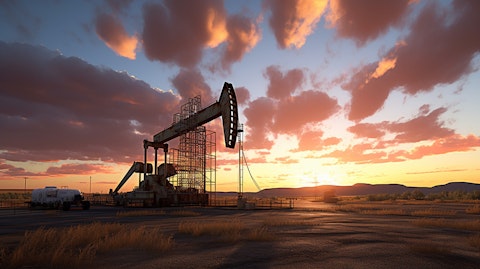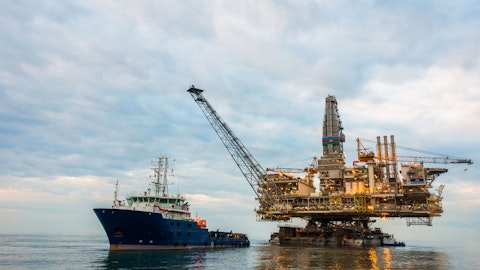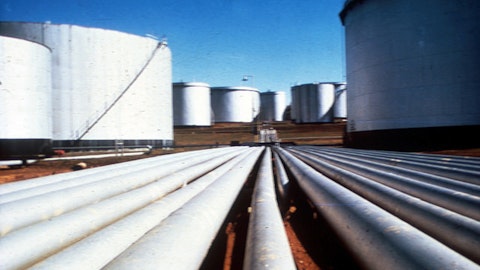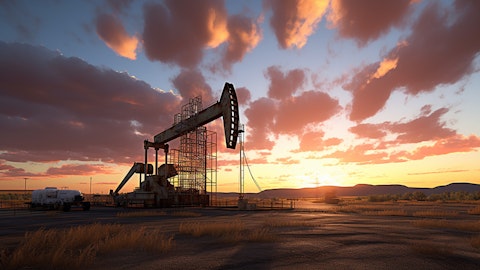Ovintiv Inc. (NYSE:OVV) Q3 2023 Earnings Call Transcript November 8, 2023
Operator: Good day, ladies and gentlemen and thank you for standing by. Welcome to Ovintiv’s 2023 Third Quarter Results Conference Call. As a reminder, today’s call is being recorded. [Operator Instructions] Please be advised that this conference call may not be recorded or rebroadcast without the expressed consent of Ovintiv. I would now like to turn the conference call over to Jason Verhaest from Investor Relations. Please go ahead, Mr. Verhaest.
Jason Verhaest: Thank you, Joana, and welcome, everyone, to our third quarter ‘23 conference call. This call is being webcast and the slides are available on our website at ovintiv.com. Please take note of the advisory regarding forward-looking statements at the beginning of our slides and in our disclosure documents filed on SEDAR and EDGAR. Following our prepared remarks, we will be available to take your questions. Please limit your time to one question and one follow-up. I will now turn the call over to our President and CEO, Brendan McCracken.
Brendan McCracken: Good morning. Thank you for joining us. Our team delivered another quarter of impressive outperformance against our targets. We’ll get into the details in a minute. But first, I’d like to start with the steps we’ve taken to prosecute our durable returns strategy and ensured that Ovintiv is set up to create shareholder value. We believe a deep premium inventory is one of the three key ingredients to generating durable returns. Over two years ago, we recognized that the industry was likely to consume quality inventory at a rate much higher than it was replenishing. Fast forward to today and that has definitely turned out to be the case. And the growing recognition of this deficit has been a motivator for the deal flow we’ve seen recently.
We have moved against that broader industry tide and have both deepened our premium inventory and demonstrated our ability to generate superior operational and financial results to create value for our shareholders. We pioneered cube development to make the most out of the premium resource we have captured. We have continued to innovate to drive down costs and boost productivity. We have consistently converted upside locations to premium inventory by investing into organic appraisal and assessment on the acreage we already own. We closed over 200 highly accretive bolt-on transactions, and we made a significant step change with our Permian transaction earlier this year. Since 2021, we’ve added over 1,500 premium drilling locations to our inventory.
We accomplished this by following a rigorous process to allocate our capital, and as a result, we accretively grew cash flow per share, free cash flow per share and maintained a strong balance sheet. Another area of intense focus for us has been consistent execution. Although much of the market’s focus this year has been on our Permian outperformance, each basin in our portfolio is contributing to our total outperformance. Across the Company, we continue to innovate and find efficiencies that reduce cycle times, lower costs and deliver leading well productivity. From production to capital to per unit cost, we once again beat our targets and enhanced the capital efficiency of our business. Our production beat in the quarter was driven by portfolio-wide well performance and excellent operational execution to efficiently turned in line our wells.
I noted earlier that consistent execution is key to our story. And I’m proud to say the culture of innovation here at Ovintiv remains alive and well. Greg will touch more on this later, but our latest Trimulfrac innovation is unmatched in industry today and setting the leading edge efficiency frontier in the Midland Basin. Our strong execution has accelerated our wells on line and is pushing 2023 production higher and stabilizing us at our 2024 run rate and free cash flow sweet spot sooner. We previously guided to a second half 2023 oil and condensate figure of 210,000 barrels a day. Using our Q3 actuals and the midpoint of our Q4 guide, our second half production will now come in at about 219,000 barrels a day or 9,000 barrels a day above our original guide.
Finally, we’ve again raised our full year 2023 production guidance, our second raise since we closed the acquisition back in June. We have also narrowed the range and reiterated the midpoint of our 2023 capital guidance, despite bringing 15 to 20 more wells into 2023 from our program acceleration. Our third quarter results speak for themselves. Our team brought on 116 net wells, 16 more than planned, with 15 of those coming in the Permian. Our base production also outperformed, thanks to the work done by our teams to moderate decline rates. I’ll now turn the call over to Corey to cover our financial results.
Corey Code: Thanks, Brendan. Our operational success translated into strong financial results in the quarter with earnings per share of $1.47 and cash flow per share of $4.02, meeting consensus estimates. We generated free cash flow of $278 million and we returned approximately $127 million to our shareholders through share buybacks and our base dividend. Our share buyback this quarter was through participation in the EnCap secondary offering, which saw us purchase and retire 1 million shares. This buyback was an acceleration of our fourth quarter share repurchases, and as such, the $45 million we used to buy the shares will be subtracted from our planned buybacks in the fourth quarter, leaving us with $53 million of share repurchases to execute in the fourth quarter.
We also saw strong per unit cost performance with operating expense, transportation and processing expense and production, mineral and other taxes coming in below the bottom end of the guidance on a combined basis. The third quarter was our peak capital and activity quarter. As our production crests and capital returns to our new run rate, we should start reducing debt more rapidly. With just over $6.1 billion of total debt at quarter end, our leverage ratio was 1.5 times. We remain committed to our mid-cycle leverage target of 1 times or about $4 billion of total debt, assuming mid-cycle prices. The maturity profile of our recently issued bonds will allow us to optimize our debt pay-down schedule as we work towards that target. And while debt reduction is a big area of focus for us in the near-term, our shareholder return framework remains consistent.
We will continue to distribute at least 50% of post-dividend free cash flow to our shareholders with the remaining 50% going to the balance sheet. I’ll now turn the call over to Greg.
Greg Givens: Thanks, Corey. The top priority since closing our Permian acquisition in June has been the rapid and efficient integration of the assets into our existing business, and I couldn’t be more pleased with how the team has performed. Not only did we complete the integration ahead of schedule, but we also accelerated the time line of wells in progress that were inherited with the transaction. Along with strong well performance across the portfolio, this acceleration was a driving factor in our production beat and raise for the third and fourth quarters. As Brendan mentioned, this acceleration has brought forward the wave of peak production and will allow us to stabilize our run rate at 200,000 barrels of oil and condensate per day in the second quarter of 2024.
We have completed all the outstanding DUCs and are running 5 rigs and 1 frac spread in the Permian today, which is reflective of our run rate activity level going forward. Our Permian well performance continues to be very strong. Our legacy footprint is seeing year-over-year oil productivity per foot increase of more than 20%. This is primarily driven by a combination of completions design, real time monitoring and stage architecture optimization. It is also worth highlighting that our consistent cube development approach currently ranks first in year-to-date oil productivity per foot versus key peers in the Midland Basin. The wells on our recently acquired acreage are performing in line with our expectations and have an average oil IP30 exceeding the 2022 and 2023 Midland basin average.

Of the wells we brought on line on the new acreage since close, approximately 20 individual wells have shown IP30 oil rates of more than 1,100 barrels per day. We are optimistic about the 250 high potential locations we identified in the early days of the acquisition and are actively testing those areas in horizons today. Across the portfolio, we typically allocate about 10% of our D&C activity to testing upside locations, and we are taking the same approach here. As we’ve noted previously, we see opportunities to increase well performance and capital efficiency on the acquired assets as we apply Ovintiv’s drilling and completion approach. We expect to see our first end to end Ovintiv designed wells on line late in the fourth quarter of this year.
Our focus on efficiency and innovation has been key in delivering leading well performance in the Permian. While our cube development approach has stayed consistent, we are constantly looking for ways to make our wells more productive and less costly. Our enhanced completions have resulted in well performance exceeding type curve expectations, and we’ve been able to achieve this without an increase to well cost. The simplest path to mitigate higher cost is to increase efficiencies and reduce the amount of time spent on location, and that is exactly what we are doing. Over the last few years, we have realized significant savings utilizing local wet sand along with our Simulfrac operations, but our Permian team has taken this one step further.
We are stockpiling wet sand on-site from our local mines and completing three wells with the single frac spread at the same time, a technique we’ve dubbed Trimulfrac frac. Trimulfrac is reducing cycle time and saving costs. About a quarter of our Permian wells in 2023 will be completed with this technology, and we expect to use it in more than half of our program next year. The results are impressive. For example, on our recent Driftwood pad, we saved an additional $125,000 per well when compared to Simulfrac. We were also able to bring the pad on line sooner with our increased efficiencies, achieving almost 4,200 feet of completed lateral per day. With the pad online sooner, it will have an incremental 55 production days in 2023, directly increasing our capital efficiency.
This step change in efficiency is easy to observe but difficult to replicate and is unmatched in the industry today. Highly sophisticated logistics management is essential to execute these more complex operations, and this is where our team excels. Our Montney performance continues to demonstrate the expertise of our team in maximizing value from the play. Once again, Ovintiv dominates the list of most productive wells in the play with our results accounting for over two-thirds of the top wells in the basin and a clean sweep of the top 20. The Montney is one of the largest remaining oil plays in North America, and our 2023 program continues to target that oil and condensate rich parts of our acreage, where we have over a decade of premium and drilling inventory.
Western Canada is a net importer of condensate, and this means we generally receive prices near or above WTI for our product. Year-to-date, we’ve realized 97% of WTI making the Montney competitive with the top oil basins in North America. In Uinta, our two-rig second half-weighted program is delivering exceptional well results. We recently brought on line our nine-well Tomlin pad with an IP30 rate of 1,490 barrels of oil per day per well. This recent pad, along with the other wells brought on line year-to-date are set to outperform the Delaware. Another high-pressure oily basin by almost 10% through the first 365 days, pretty strong results for a play that is still emerging. Our large contiguous land base of approximately 130,000 net acres has multiple benches across about 1,000 feet of collective pay.
It is 80% undeveloped, which translates into significant inventory runway. Our scalable rail capacity to the Gulf Coast, where we rail about 30% to 40% of our volumes diversifies market exposure and supports our future development plans. Due to the high oil nature of this play, year-to-date, the Uinta has been competitive with our Permian asset for the highest operating margin in our portfolio. The Anadarko team has done a great job optimizing efficiencies in the play. After pulling back the program earlier this year due to weakness in natural gas and NGL prices, the team had the opportunity to be patient and opportunistic and securing a competitively priced frac crew to complete our remaining DUCs in the fourth quarter. This will see us bring on a total of 26 turned in lines for the year.
The team has also managed our base production very effectively and has cut base declines in half to about 20% since 2021. The Anadarko continues to be a strong free cash flow generating asset in 2023 and is a premier multiproduct option in our portfolio. I’ll now turn the call back to Brendan.
Brendan McCracken: Thanks, Greg. Yesterday, we provided our fourth quarter guidance and updated our 2023 full year guide to reflect the improved well productivity across the portfolio and the accelerated turned in line timing in the Permian. The fourth quarter will be the high point for production this year. This reflects the impact of continued strong well results as well as the accelerated production momentum from the new Permian assets as we continue to bring the WIPs on line ahead of schedule. If we compare back to our 2023 guidance at acquisition close, we have raised our expected total production by 4% while reducing our projected capital spend by about 2%, resulting in a capital efficiency improvement of about 6% since June.
Our strong execution in 2023 is setting us up for continued success in 2024. We are again reaffirming our 2024 plan. Our plan maximizes return on invested capital and free cash generation. Our normalized and load-level program achieves this production level with $465 million less capital than 2023 and about 100 fewer net turned in lines. Our turned in line cadence in the fourth quarter will be front-end weighted with more than 90% of the total company wells coming on line in October and November. As expected, our production will decline during the first quarter of 2024 before reaching our go-forward run rate of 200,000 barrels a day in the second quarter. In addition to the refinements to the 2024 scenario, we’ve included a preliminary cash tax outlook.
We have mentioned previously that we act to be subject to AMT next year. We recently completed an extensive project to identify and claim R&D credits. This was a multiyear study that resulted in $122 million of credits to reduce our 2024 tax in the United States. That savings is reflected in the estimates on slide 20 in our appendix. In summary, our durable returns strategy is working very well. I’d like to recognize our team for the outstanding operational and financial results we’ve delivered year-to-date and acknowledge their relentless drive for further innovation to make our business more valuable for our shareholders. We have significantly added to our inventory depth, successfully integrated the acquisition into our existing operations and have efficiently accelerated the inherited wells in progress inventory.
We see opportunities for further upside going forward, and we are eager to bring our fully Ovintiv designed and executed wells on line before the end of the year. We once again increased our full year 2023 production guidance, and we’ve tightened the range on our capital spending. And over the long term, we believe that value creation in the E&P space will come from companies that can demonstrate durability in both the return on invested capital and the return on cash to shareholders. We are positioned to deliver on this value proposition through our relentless focus on innovation, execution, disciplined capital allocation, responsible operations and leading capital efficiency. This concludes our prepared remarks. Operator, we’re now ready to open the line for questions.
Operator: [Operator Instructions] First question comes from Neal Dingmann from Truist Securities. Please go ahead.
See also Top 20 Drug Companies in the US by Revenue and 11 Best S&P 500 Stocks To Buy According to Ray Dalio’s Bridgewater Associates.
Q&A Session
Follow Ovintiv Inc. (NYSE:OVV)
Follow Ovintiv Inc. (NYSE:OVV)
Neal Dingmann: Thanks for the time, guys. Very nice quarter. My first question for the team is on the Permian specifically. Sort of like the — just the expansion of the operation. I’m just wondering, could you speak to the future potential project size changes there? And are you able to continue to expand the lateral length in most of the areas. So just wondering on those two aspects of the play.
Brendan McCracken: Yes. Neal, we appreciate it, and I’ll get Greg to weigh in on some of the details here. But broadly speaking for us in the Permian, you should expect consistent lateral lengths year-over-year. And then, as far as occupation size, again, very consistent. In fact, if you go back over our last several years of Permian programs, they’ve been very consistent from an occupation size and also a well spacing perspective. In fact, 2023 and 2022 were the exact same wells per section, actually up a little bit on wells per section from 2021. So, ‘23 and ‘22 up about 15% on wells per section, but very consistent. And so, we’re seeing that strong well performance without any upspacing in our go-forward programs. But Greg, maybe you want to comment on Neal’s thoughts on the program.
Greg Givens: Yes. I guess the first thing you’ll see that will be a little different going forward, we always try to do things in multiples before because that fit very well to our Simulfrac technique. Going to Trimulfrac, you’ll see things in multiple of 6. That’s the way Trimulfrac works. As you frac three wells at a time, while you prep the other three wells. So some slight shifts there, but you should see very similar overall occupation size and similar lateral length, as Brendan alluded to.
Neal Dingmann: And then just, Brendan, a follow-up on the shareholder return, you guys are making just tremendous progress on the debt repayment in addition to having that solid shareholder return. So I’m just wondering — I know you’ve got that debt target of around $4 billion. Just wondering, thoughts about potentially accelerating the shareholder payout given what some others have done, maybe even before you get to that $4 billion, or maybe just talk about how you’re thinking about that overall plan.
Brendan McCracken: Yes. No, appreciate it, Neal. I think we’re going to stay consistent with the shareholder return framework that we’ve been following, and we think that is a great balance of allowing us to create value for our equity shareholders, both through the cash return, but also by reducing debt and converting that enterprise value to the equity holders from the debt holders. So, I think for us, it makes sense to stay in that 50-50 mode and be consistent there. And really, what we’re excited about is accelerating into that free cash flow sweet spot and just overall generating more free cash flow for both debt reduction and cash returns.
Operator: The next question comes from Gabe Daoud from TD Cowen. Please go ahead.
Gabe Daoud: Hey. Thanks. Good morning, everyone. Thanks for taking the time and thanks for all the prepared remarks. Brendan, was hoping we could maybe talk a bit about ‘24. Just curious how much of your recent productivity and efficiency gains have you embedded in the program, the capital figure and the production figures. Just trying to get a sense if there’s maybe downside risk to capital given Trimulfrac and then upside risk to production volumes.
Brendan McCracken: Hey Gabe. Yes, I appreciate the question. So, we’ve been very consistent with our projection on 2024 that will stabilize at that 200,000 barrels a day and at that capital range. So really, we hadn’t changed any of that in the projection that you saw today. I would say sitting here now, we feel highly confident in that projection. And to be clear, we expect to be at least 200,000 barrels a day in every quarter next year. And so, so far, we haven’t changed the basis that we used to prepare that projection. We’re, of course, very encouraged by the outperformance that we’ve been seeing all year on productivity. And also the performance that we’re seeing on capital execution and what that means for cost savings.
We just think it makes sense to get all of the long-dated production data from as many wells as possible before we update or change that 2024 projections. So, I think the results this quarter and all year speak for themselves, and we’re excited to continue that through the fourth quarter here and into next year when we update that ‘24 guide.
Gabe Daoud: And then, I guess, just as a follow-up, I’d love to get maybe some updated thoughts around industry consolidation. Obviously, the 3 for — with EnCap and integration is obviously going incredibly well, but just curious to hear your updated thoughts on Permian consolidation and just general industry consolidation. Thanks, guys.
Brendan McCracken: Yes. No, I appreciate it. Gabe, it’s obviously been an area of focus for the industry. I think for us, we’ve been very focused on execution and the digestion and integration of the transaction that we undertook earlier this year and the bolt-ons that we had undertook in the two years prior. So, we think our durable returns strategy has been very effective here. And we’ve done a lot in this space. And I alluded to in the prepared remarks, over 1,500 premium locations added over the last couple of years. And you can see that showing up in our results. So, I think for us, really focused on executing and creating value off the platform that we’ve created.
Operator: Thank you. The next question comes from Doug Leggate from Bank of America. Please go ahead.
Doug Leggate: Brendan, I wonder if I could just ask you to maybe push you a little bit on two things you just mentioned. The first one is your CapEx guide for next year is $2.1 billion to $2.5 billion, still pretty wide. But this step-up in Trimulfracs, if I’m pronouncing that correctly, to 50% from 25% and the cost savings. It seems to me that you’re — you got to be pointed towards at least the lower end of that range, if not below. What can you tell us about that? And then, my second question, which is related is I just want a clarification really. Has any of the 20% legacy improvement — legacy well improvements or the application of the Ovintiv design to the legacy EnCap assets, are any of those included in that 200 base? Because that 200 base has been in place for quite a while.
Brendan McCracken: Yes. Doug, I mean, I’ll take them in reverse order here. So no, we haven’t changed the basis upon which we prepared that 200,000 barrel a day projection. You remember, right, it’s actually been in place since late Q1 when we announced the transaction and felt like we needed to give some color to 2024. So yes, no change to that. So we’ll obviously be incorporating the results that we’ve seen and putting them into a go-forward update in February when we traditionally would guide for ‘24. And then on the CapEx side, look, I think the — at any given moment over the last few months, the sentiment on inflation, deflation has moved around a fair bit. I think it’s fair to say. I think we’re still seeing the potential for some overall deflation.




